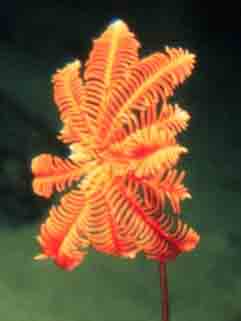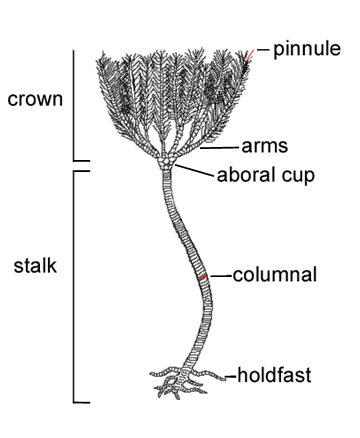Sign up for Lesson Plans, discounts & more!
Crinoid Body Parts

Crinoids like all echinodermata have 5 sections and are radially symmetrical (picture a starfish). The sea lilies are permanently fastened to the sea floor by a holdfast (a root-like structure).
The stalk is made up of small calceras sections called columnal which are held together by ligaments. The columnal are stacked up like tires at the dump. They have a hollow center that contains coelomic and neural tissue (basically these are the vital organs for movement, digestion, respiration, and reproduction).
The Stalks can reach lengths of several meters. On top of the stalk is the aboral cup. It is made up of several plates which form a ring. There are usually 2 or 3 of these rings. This contains both the mouth and anus which are on the upper side of the cup. There can be additional rings which extend the size of the calyx (aboral cup). The arms extend from the cup. They are also made up of plates. They can have many branches. In modern crinoids the branches have feather-like growths called pinnules. The pinnules have rows of tube feet on each side of a groove running down the center. This groove is connected through the arms to the mouth. It is an extension of the coelomic and neural tissue.

Feet On Their Arms! All crinoids are or were filter feeders. The arms gather food that floats past. This animal is able to move it's crown to face the flow of water. This helps it gather more food. The arms are covered with tiny tube feet that can capture the food particles. The feet pass these particles on to the center of the arm where there is a grove that transports it to the mouth. Their food consists of algae, invertebrate larva, small crustaceans, and other bits of organic matter.
Check out some of the Educational Materials for sale on our sister site fossilicious.com.

interested in more? If so, you may want to check out our other sites:
fossilicious.com - Our online fossil and mineral rock shop.
rocksandminerals4u.com - An educational site about rocks, minerals, and geology.
Geologic Time Geologic Time Line
Cenozoic Era
Quaternary
Neogene
Paleogene
Mesozoic Era
Cretaceous
Jurassic
Triassic
Paleozoic Era
Permian
Carboniferous
Devonian
Silurian
Ordovician
Cambrian
Archean Time
Hadean Time
Teachers Resources
Activities for Education and Fun
Earth Science Lesson Plans
Activities For Kids
Fossil Lesson Plans
Fossil Activities
Education Articles
Coloring Pages
Dinosaur Coloring Pages
Montessori Materials
Geology Club
Fossil Hunting
 |
 |
 |




